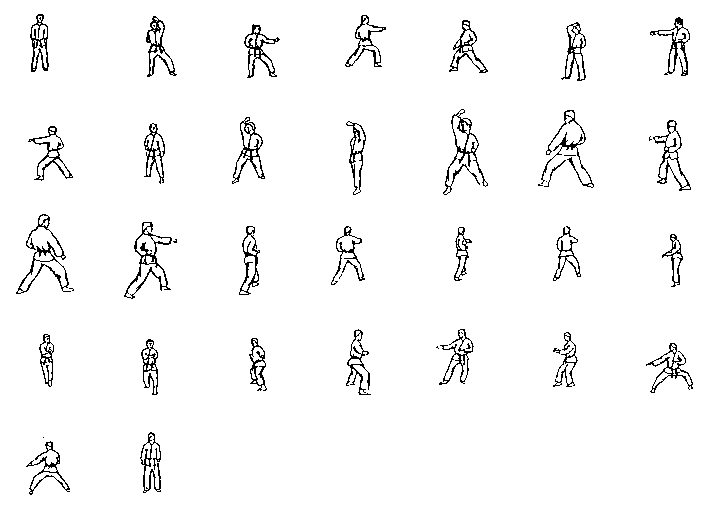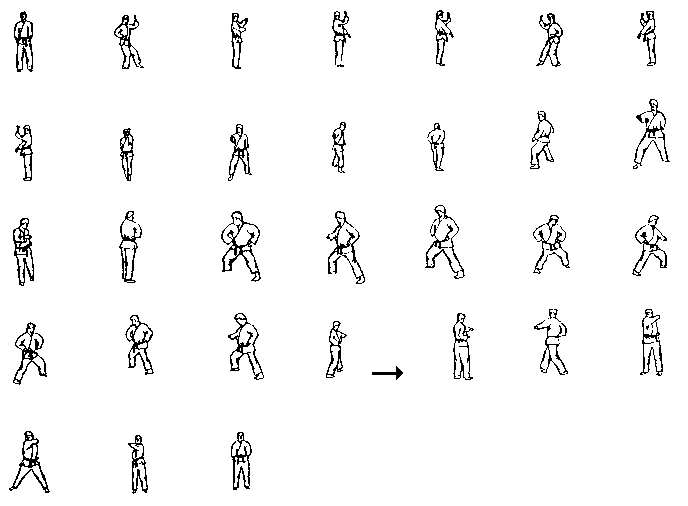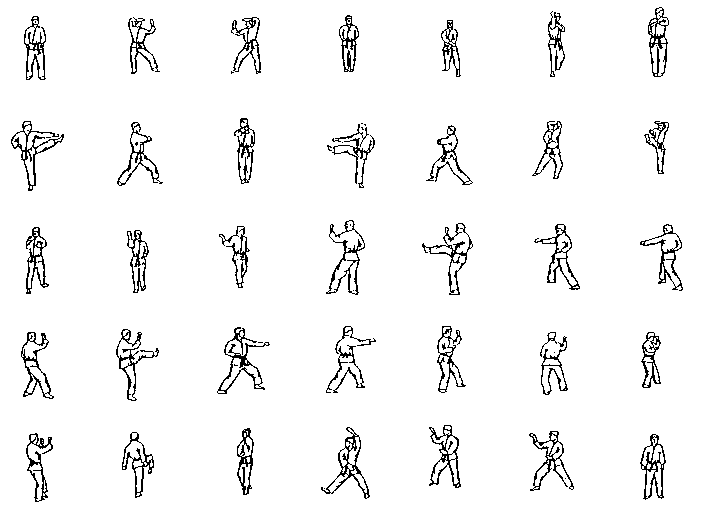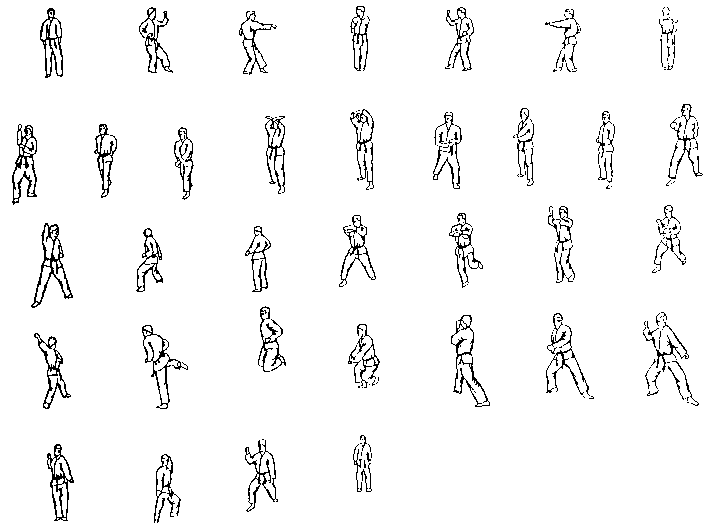![]()
Kata Page
The Kata's Below are Pinan's 1-5
Pinan Shodan

![]()
Pinan Nidan

![]()
Pinan Sandan

![]()
Pinan Yodan

![]()
Pinan Godan


Here is a Link to a Site For
Pinan & Advanced Kata's Step by Stephttp://robs.wado-karate.nl/wado-karate-1-e.htm
Click "Kata" in Menu

Pinan Kata's
Pinan means peace or peaceful mind, The Pinan katas were composed in 1907 by Anko Itosu who was 77 at the time. These katas were originally intended to teach karate basics in Okinawan High School physical education programs in the first part of this century. After being exposed to them in Japan, Ohtsuka Sensei travelled back to Okinawa to refine the Pinans and Kushanku into their original form.
The Pinans are related to parts of Kushanku, a much larger kata. They also can be comprised into the "chanan" order: Shodan, Sandan, Godan, Nidan, Yodan. The Pinans are taught at the Kyu level.
Kushanku
Kushanku roughly translates into "sky viewing" or "looking into the huge sky". This Kata was adapted and developed after it was brought to Okinawa in 1762 by a Chinese man named Kushanku. It is said to require more than a decade of painstaking practice to master.
This is the main kata for the grading to the shodan rank (first degree black belt) and one of the most difficult katas in the wado style. The Pinan katas are the building blocks that help to master Kushanku.
NiHanChi
A kata which was one of Sensei Shintani's favourites. It was formed by Ohtsuka Sensei with assistance from Choki Motobu. Nihanchin kata trains the student to produce power from the abdomen and the lower back, instead of the usual hip movement. This makes the student throw the techniques directly from the ki. The kata is characterized by the Nihanchin-dachi stance with feet pointing 45 degrees inward.
This kata consists of lateral (side-to-side) movement, and as such gives the impression that the performer is fighting with his/her back against a wall.
Chinto
Legend tells of a Chinese sailor by the name of "Chinto" that was shipwrecked and forced to steal food from a nearby village. A samurai was sent to capture the thieving sailor, and when the two met the samurai was swiftly defeated by Chinto. The samurai returned to his master stating that the village would have no more problems from the thief. The samurai and Chinto had become friends after the fight, and Chinto taught the samurai a kata later named after the sailor.
This is an advanced black belt kata characterized by explosive as well as exotic movements such as mae-geris thrown off sagiashi dachi (crane stance).
Seisan
This kata utilizes the Sanchin-dachi (hourglass stance) combined with dynamic tension, extensively working on the breathing and the ki. In contrast to the first half, the remainder of the kata is characterized by explosive sequences in alternating directions.
![]()
| Kata Name Description | |
| Pinans | (Training Katas meaning 'Peaceful Mind'.) |
| First Basic Kata | Balance, Timing, Coordination & Reflexive Thinking |
| Pinan Shodan | Defense using Free Style Sparring Techniques |
| Pinan Nidan | Introduction to Body Shifts (Tai Sabaki) |
| Pinan Sandan | Defense for Close-In Fighting |
| Pinan Yondan | Defense using Jiujitsu Techniques |
| Pinan Godan | Defense against Weapons |
| Kushanku | 'To View the Sky' - The Pinan katas 'originator' |
| Naihanchi | 'The Iron Horse' or 'Battlefield' kata. |
| Seisan | 'The Half-Moon' or '13 Hands' kata. |
| Chinto | 'Crane on a Rock'. |
| Jitte | '10 Hands'. Mastery means mastery over 10 men. |
| Jion | 'In the Jion-ji Shaolin Temple'. |
| Bassai | 'To Storm a Fortress'. |
| Neseishi | 'The 24 Steps'. |
| Rohai | 'The Mirror of the Soul' or 'White Heron'. |
| Wanshu | 'The Flying Swallow' |
| Suparinpei | '108 hands' - representing the 108 evil spirits of man. Also said to have represented a band of 108 warriors that travelled the chinese countryside in the 1600s performing 'Robin Hood' type tasks of doing good deeds, giving to the poor, etc. |
| Unsu | 'Defense of a Clouds' or 'Cloud Hand'. |
![]()
Home Page The Club Terminology Grading Syllabus Karate History
Links Tatsuo Suzuki Junior Section